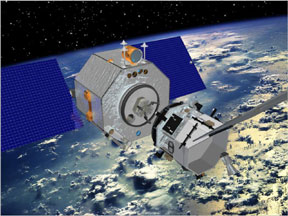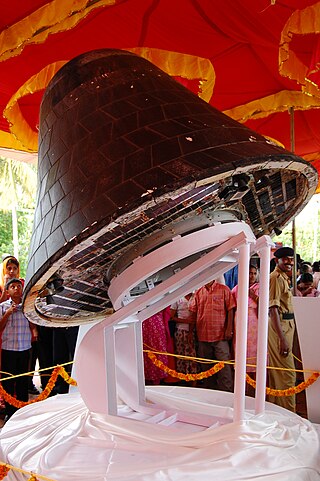
This article outlines notable events occurring in 2005 in spaceflight, including major launches and EVAs. 2005 saw Iran launch its first satellite.

Orbital Express was a space mission managed by the United States Defense Advanced Research Projects Agency (DARPA) and a team led by engineers at NASA's Marshall Space Flight Center (MSFC). The Orbital Express program was aimed at developing "a safe and cost-effective approach to autonomously service satellites in orbit". The system consisted of two spacecraft: the ASTRO servicing satellite, and a prototype modular next-generation serviceable satellite; NEXTSat. The mission launched from Cape Canaveral Air Force Station on 8 March 2007, aboard an Atlas V expendable launch vehicle. The launch was part of the United States Air Force Space Test Program STP-1 mission.

The year 2007 contained several significant events in spaceflight, including a Chinese ASAT test, the launches of the US Phoenix and Dawn missions to study Mars and Asteroid belt respectively, Japan's Kaguya Lunar orbiter, and the first Chinese Lunar probe, Chang'e 1.
Autonomous Space Transport Robotic Operations (ASTRO), was an American technology demonstration satellite which was operated as part of the Orbital Express program. It was used to demonstrate autonomous servicing and refuelling operations in orbit, performing tests on the NEXTSat satellite which was launched with ASTRO for that purpose. Launched in March 2007, it was operated for four months, and then deactivated in orbit.
The Space Test Program (STP) is the primary provider of spaceflight for the United States Department of Defense (DoD) space science and technology community. STP is managed by a group within the Advanced Systems and Development Directorate, a directorate of the Space and Missile Systems Center of the United States Space Force. STP provides spaceflight via the International Space Station (ISS), piggybacks, secondary payloads and dedicated launch services.

USA-200, also known as NRO Launch 28 or NROL-28, is an American signals intelligence satellite, operated by the National Reconnaissance Office. Launched in 2008, it has been identified as the second satellite in a series known as Improved Trumpet, Advanced Trumpet, or Trumpet follow-on; a replacement for the earlier Trumpet series of satellites.
Kosmos 202, also known as DS-U2-V No.4, was a Soviet satellite which was launched in 1968 as part of the Dnepropetrovsk Sputnik programme. It was a 325 kilograms (717 lb) spacecraft, which was built by the Yuzhnoye Design Office, and was used to conduct classified technology development experiments for the Soviet armed forces.
Discoverer 21, also known as RM-2, was an American satellite which was launched in 1961. It was a technology demonstration spacecraft, based on an Agena-B.
Discoverer 19, also known as RM-1, was an American satellite which was launched in 1960. It was a technology demonstration spacecraft, based on an Agena-B.
KySat-1 was an American satellite which was to have been operated by Kentucky Space. Designed to operate for eighteen to twenty four months, it was lost in a launch failure in March 2011 after the Taurus launch vehicle carrying it failed to achieve orbit.
Hermes was an American satellite which was to have been operated by the Colorado Space Grant Consortium. Intended to perform technology demonstration experiments in low Earth orbit, it was lost during launch in March 2011 when the rocket that was carrying it failed to achieve orbit.

OPS 5111, also known as Navstar 1, NDS-1, GPS I-1 and GPS SVN-1, was an American navigation satellite launched in 1978 as part of the Global Positioning System development program. It was the first GPS satellite to be launched, and one of eleven Block I demonstration satellites.
OPS 5112, also known as Navstar 2, NDS-2, GPS I-2 and GPS SVN-2, was an American navigation satellite launched in 1978 as part of the Global Positioning System development programme. It was the second of eleven Block I GPS satellites to be launched.
OPS 5113, also known as Navstar 3, GPS I-3 and GPS SVN-3, was an American navigation satellite launched in 1978 as part of the Global Positioning System development programme. It was the third of eleven Block I GPS satellites to be launched.
OPS 5114, also known as Navstar 4, GPS I-4 and GPS SVN-4, was an American navigation satellite launched in 1978 as part of the Global Positioning System development programme. It was the fourth of eleven Block I GPS satellites to be launched.
OPS 5117, also known as Navstar 5, GPS I-5 and GPS SVN-5, was an American navigation satellite launched in 1980 as part of the Global Positioning System development programme. It was the fifth of eleven Block I GPS satellites to be launched.
OPS 5118, also known as Navstar 6, GPS I-6 and GPS SVN-6, was an American navigation satellite launched in 1980 as part of the Global Positioning System development programme. It was the sixth of eleven Block I GPS satellites to be launched.
OPS 9794, also known as Navstar 8, GPS I-8 and GPS SVN-8, was an American navigation satellite launched in 1983 as part of the Global Positioning System development program. It was the eighth of eleven Block I GPS satellites to be launched.
USA-1, also known as Navstar 9, GPS I-9 and GPS SVN-9, was an American navigation satellite launched in 1984 as part of the Global Positioning System development programme. It was the ninth of eleven Block I GPS satellites to be launched, and the first satellite to receive a USA designation.
USA-5, also known as Navstar 10, GPS I-10 and GPS SVN-10, was an American navigation satellite launched in 1984 as part of the Global Positioning System (GPS) development programme. It was the tenth of eleven Block I GPS satellites to be launched.




